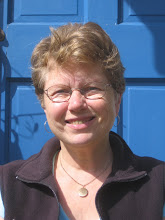 This year marks the 50th anniversary of the Cape Cod
This year marks the 50th anniversary of the Cape Cod  National Seashore. We are fortunate, here on the Outer Cape, to have this park and all the natural beauty it offers, preserved forever. If President Kennedy had not owned a home in Hyannisport, the Outer Cape would be way more developed today. I always remind guests that 61% of Wellfleet is located within the Seashore boundaries. If you drive up Route 6, you will see the headquarters and Salt Pond Visitor Center, above, on your right, at one of the traffic lights. There's a second visitor center in Provincetown, not open until next month. I send guests to the Eastham location.
National Seashore. We are fortunate, here on the Outer Cape, to have this park and all the natural beauty it offers, preserved forever. If President Kennedy had not owned a home in Hyannisport, the Outer Cape would be way more developed today. I always remind guests that 61% of Wellfleet is located within the Seashore boundaries. If you drive up Route 6, you will see the headquarters and Salt Pond Visitor Center, above, on your right, at one of the traffic lights. There's a second visitor center in Provincetown, not open until next month. I send guests to the Eastham location. Have you visited the new permanent exhibit there yet? Yesterday I stopped by and checked out a couple interesting artifacts from the Carns site, on display in "People of the First Light." The exhibit is open seven days a week from 9 to 4:30 but mark your calendars now and try to attend May 14th. From 10 to 12:30, Wampanoag artists will demonstrate weaving and woodworking. From 1 to 2, there will be a performance by the Wampanoag Nation Singers and Dancers. And, from 2:30 to 3:30 visitors are invited to drop in and share memories of the Carns Site excavation.
The Carns site got its name
 when a retired archeologist happened to notice something unusual while out walking and sounded the alert. The year was 1990, year of the "perfect storm." Archeologists were called in and did their best to excavate before the sands shifted again.
when a retired archeologist happened to notice something unusual while out walking and sounded the alert. The year was 1990, year of the "perfect storm." Archeologists were called in and did their best to excavate before the sands shifted again.One of the archeologists, who participated in the Carns site dig,
 was a guest at Chez Sven several weeks ago. He explained how erosion had removed a section of the beach so you could see the level where people had once lived. The site had been under ten feet of sand at the time. A darker layer of sediment was uncovered. The plow marks indicated to the assembled archeological team that the site “couldn’t be that old.” Only 1000 years or so. It has washed away now. Our guest also said sand used to move across the plains of Eastham at such a rate that the area was referred to as “Africa.” The coast used to be one mile to the east. Nauset Marsh would have been fresh water.
was a guest at Chez Sven several weeks ago. He explained how erosion had removed a section of the beach so you could see the level where people had once lived. The site had been under ten feet of sand at the time. A darker layer of sediment was uncovered. The plow marks indicated to the assembled archeological team that the site “couldn’t be that old.” Only 1000 years or so. It has washed away now. Our guest also said sand used to move across the plains of Eastham at such a rate that the area was referred to as “Africa.” The coast used to be one mile to the east. Nauset Marsh would have been fresh water. In the post about our conversation over breakfast, I described discovery on an ossuary on Indian Neck. One thing I neglected to mention was the fact Native Americans would bury family members in separate graves, then un-bury them and place all the bones in one hole, to reestablish, in death, the community that had lived together in life. Interesting!




